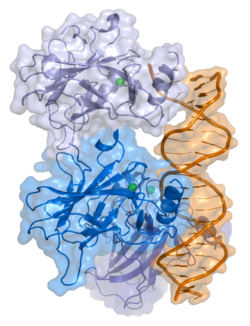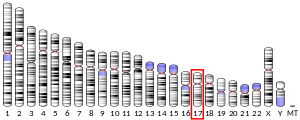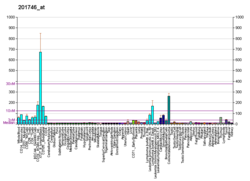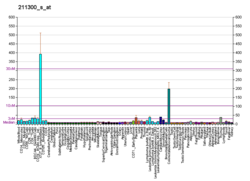p53
p53 הוא חלבון מדכא גידולים המקדם אפופטוזה או מוות תאי בתגובה לנזקי DNA. משמש כמנגנון הגנה לתאים. נקרא גם "שומר הגנום"
החלבון הוא גורם שעתוק הפועל על ידי ויסות פעולתם של גנים אחרים הקשורים למחזור התא. לפיכך, כאשר החלבון או הגן המקודד אותו לא בא לידי ביטוי הוא עלול לגרום להתפתחות גידולים.
באופן נורמלי נמצא p53 בציטופלזמה במצב בלתי-פעיל, אז הוא מעוכב על ידי חלבון Mdm2, אך בעקבות עקה שנגרמת מקרינה מייננת או חומר מסרטן מופעל החלבון p53 על ידי החלבון ATM, וכאשר הוא נכנס לגרעין התא הוא גורם לשעתוק הגן המקודד לחלבון p21, המעכב קינאזים הכרחיים לשכפול הדנ"א. ברוב התאים הסרטניים, כלומר במצב לא תקין, מנוטרלת פעילותו של החלבון p53 והדנ"א הפגום משוכפל. אף על פי שפעמים רבות נמצא החלבון בכמות גדולה הוא לרוב מוטנטי או שאינו מופעל בגלל חלבון ATM מוטנטי.
הגן המקודד ל-p53 שוכן על גבי כרומוזום 17 באדם. החלבון מורכב מ-393 חומצות אמינו. התמונה ממחישה את המבנה של החלבון כאשר הוא עובר אינטראקציה עם DNA. כאשר החלבון נמצא באינטראקציה עם DNA יש לו מבנה שונה[דרושה הבהרה], לאו דווקא מוגדר.
החלבון התגלה לראשונה ב-1979 על ידי שש מעבדות שונות באופן עצמאי. אחת מהן הייתה פרופ' ורדה רוטר ממכון ויצמן והגן שוכפל לראשונה באופן מלאכותי על ידי פרופ' משה אורן ממכון ויצמן ב-1983. רק ב-1989 התגלו תכונותיו האנטי-סרטניות. בתחילה הוא היה נחשב בטעות כאונקוגן אך רק יותר מאוחר התברר שהוא גן שמונע התפתחות גידולים (Tumour Suppressor).
מוטציה בP53 תגרום בדרך כלל לסרטן.
קישורים חיצוניים
עריכה- מגזין מכון ויצמן, שלושים שנה לגילוי הגן P53, באתר "הידען", 6 במרץ 2010
הערות שוליים
עריכה- ^ 1 2 3 GRCh38: Ensembl גרסה 89: ENSG00000141510 - Ensembl, מאי 2017
- ^ 1 2 3 GRCm38: Ensembl גרסה 89: ENSMUSG00000059552 - Ensembl, מאי 2017
- ^ "Human PubMed Reference:".
- ^ "Mouse PubMed Reference:".






